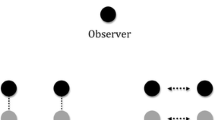Abstract
In this paper I consider the relationship between the spatial properties of visual perceptual experience and the sense-datum inference. I argue that the sense datum inference should be accepted if spatial properties are not merely intentionally present in such experiences. This result serves to underline the seriousness of the difficulties that are presented to direct realism by a particular class of illusory spatial experiences based on the geometry of visual perceptual experience. In light of these considerations I argue that it is a constraint on direct realism that the underlying spatial character of visual perceptual experiences must be the same as that of the physical world.
Similar content being viewed by others
Notes
See, for example, Peacocke (1983).
See, for example, Boghossian and Velleman (1989).
There is a tendency among even the most scrupulously thorough philosophers to betray some confusion about spatial properties in this regard. Peacocke, for instance, writes, “… we are not saying that experiences have colour properties or spatial properties.”, but on the next page goes on the say, “… the fact that an object does subtend a large visual angle does causally explain its presentation in a large region of the visual field” (Peacocke 1983). The question naturally arises: what is the ‘region of the visual field’ a region of, if not a region of space?
Compare also what we should say about other properties that can be instantiated by objects belonging to very different ontological categories, e.g. number properties (if numbers be properties): it would not be right to say that a material object is one, whereas the corresponding element of a perceptual experience of it is one’.
References
Angell RB (1974) The geometry of visibles. Nous 8:87–177
Armstrong DM (1961) Perception and the physical world. Routledge and Keegan Paul, London
Bennett Jonathan (1966) Kant’s analytic. Cambridge University Press, Cambridge
Boghossian P, Velleman D (1989) Colour as a secondary property. Mind 98:81–103
Clark A (2000) A theory of sentience. Oxford University Press, New York
Cohen W (1957) Spatial and textural characteristics of the Ganzfeld. Am J Psychol 70:403–410
French RE (1987) The geometry of vision and the mind body problem. Peter Lang, New York
Heelan P (1983) Space perception and the philosophy of science. University of California Press, Berkeley
Jackson F (1977) Perception: a representative theory. Cambridge University Press, Cambridge
Lowe EJ (1996) Subjects of experience. Cambridge University Press, Cambridge
Lowe EJ (2008) Illusions and Hallucinations as evidence for sense data. In: Wright E (ed) The case for qualia. The MIT Press, Cambridge
Peacocke C (1983) Sense and content: experience, though, and their relations. Clarendon Press, Oxford
Robinson H (1994) Perception. Routledge, London
Rosenthal DM (2001) Colour, mental location and the visual field. Conscious Cogn 10(1):85–94
Ross PW (2001) The location problem for colour subjectivism. Conscious Cogn 10(1):42–59
Smith AD (2002) The problem of perception. Harvard University Press, Cambridge
Strawson PF (1966) The bounds of sense: an essay on Kant’s critique of pure reason. Methuen, London
Suppes P (1977) Is visual space Euclidean? Synthese 35:397–421
Tye M (1984) The adverbial approach to visual experience. Philos Rev 93:195–225
Author information
Authors and Affiliations
Corresponding author
Rights and permissions
About this article
Cite this article
Meadows, P.J. Space and the Sense Datum Inference. Topoi 35, 601–609 (2016). https://doi.org/10.1007/s11245-015-9331-6
Published:
Issue Date:
DOI: https://doi.org/10.1007/s11245-015-9331-6




